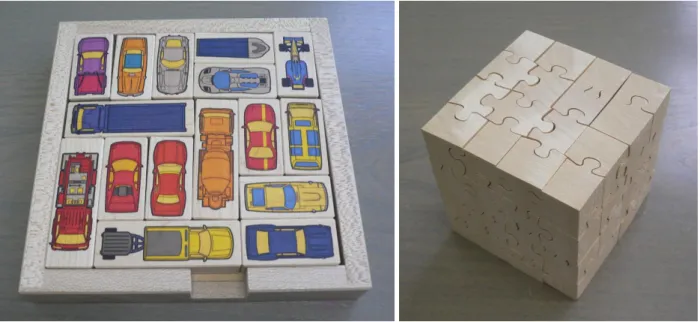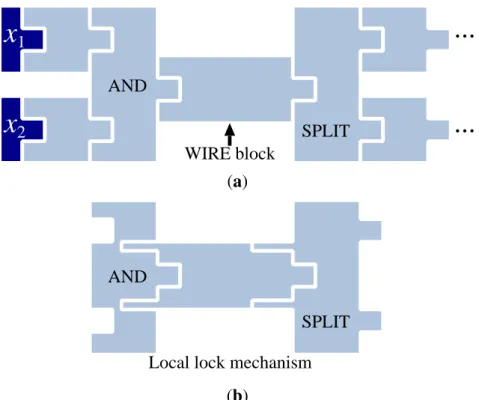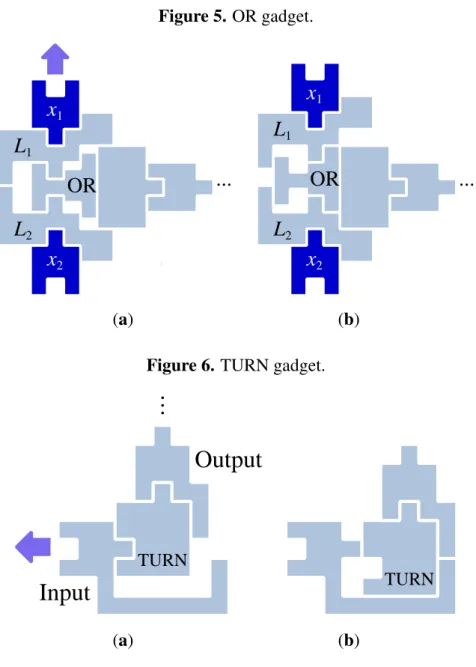The MIT Faculty has made this article openly available. Please share how this access benefits you. Your story matters.
Citation Demaine, Erik D., Martin L. Demaine, and Ryuhei Uehara. “Any Monotone Function Is Realized by Interlocked Polygons.” Algorithms 5, no. 4 (March 19, 2012): 148–157.
As Published http://dx.doi.org/10.3390/a5010148
Publisher MDPI AG
Version Final published version
Citable link http://hdl.handle.net/1721.1/86068 Terms of Use Creative Commons Attribution
Algorithms 2012, 5, 148-157; doi:10.3390/a5010148 OPEN ACCESS
algorithms
ISSN 1999-4893 www.mdpi.com/journal/algorithms ArticleAny Monotone Function Is Realized by Interlocked Polygons
Erik D. Demaine1, Martin L. Demaine1and Ryuhei Uehara2,*
1 Computer Science and Artificial Intelligence Lab, Massachusetts Institute of Technology, MA 02139,
USA; E-Mails: edemaine@mit.edu (E.D.D.); mdemaine@mit.edu (M.L.D.)
2 School of Information Science, Japan Advanced Institute of Science and Technology,
Ishikawa 923-1292, Japan
⋆ Author to whom correspondence should be addressed; E-Mail: uehara@jaist.ac.jp;
Tel.: +81-761-51-1220; Fax: +81-761-51-1149.
Received: 15 November 2011; in revised form: 13 March 2012 / Accepted: 14 March 2012 / Published: 19 March 2012
Abstract: Suppose there is a collection of n simple polygons in the plane, none of which overlap each other. The polygons are interlocked if no subset can be separated arbitrarily far from the rest. It is natural to ask the characterization of the subsets that makes the set of interlocked polygons free (not interlocked). This abstracts the essence of a kind of sliding block puzzle. We show that any monotone Boolean function f on n variables can be described by m = O(n) interlocked polygons. We also show that the decision problem that asks if given polygons are interlocked is PSPACE-complete.
Keywords: computational complexity; interlocked polygons; monotone boolean function; sliding block puzzle
1. Introduction
Since Sam Loyd invented the famous 15-puzzle, sliding block puzzles have played an important role in mathematical recreations. There are many variations of sliding block puzzles (Figure1), and they have been investigated widely (see a comprehensive handbook [1]). Recently, a new framework using games on graphs is developed, and many complexity results of these puzzles are settled [2]. In most of these puzzles, for a given initial state, we aim at finding a way to its goal state. Sometimes, the difficulty of the puzzles is changed if we change the initial state. For example, the 15-puzzle becomes much easier if we remove two or more pieces from (potentially) sixteen pieces. In the puzzles in Figure 1, if we remove
more pieces, the problems (getting out a specified car or disassembling the puzzle) become easier. That is, in a sliding block puzzle, fewer pieces mean easier in general. We investigate such a monotonicity of the sliding block puzzles.
Figure 1. Typical sliding block puzzles in 2D and 3D.
Suppose we have a collection of n simple polygons in the plane, none of which overlap each other. We call the polygons interlocked if no subset can be separated arbitrarily far from the rest. Otherwise, we say them free. If we remove a subset S of the polygons, the remaining polygons might or might not be interlocked.
Define δ(S) = 1 if the remaining polygons become free after removing S, and δ(S) = 0 if they remain interlocked. Clearly f is monotone: if S ⊆ S′, then δ(S) ≤ δ(S′). (Removing more makes the polygons less interlocked.)
Then, which monotone Boolean functions f can be described by n interlocked polygons? Figure 2
shows some simple examples. For a specified n and k, this technique can design n interlocked polygons such that removing any k of them makes them all free.
Figure 2. Interlocked polygons freed by removing any one, two, or three of the polygons (from left to right).
Since the early period of computer science, monotone functions are well investigated, especially, in the context of the lower bound of circuit complexity (see, e.g., [3, Chapter 14.4]). In general, monotone Boolean functions are formed by AND and OR operations (without NOT). Such gates seem easy enough to build, but not without extra pieces that affect the function.
Algorithms 2012, 5 150
Then, can any monotone Boolean functions f on n variables be described by m > n interlocked polygons, where f operates on a particular subset of the polygons? In this paper, we give an affirmative answer to this question:
Theorem 1. For any given monotone Boolean function f on n variables x1, . . . , xn, there is a collection
S of m simple polygons with m = O(n) such that (1) S is interlocked, (2) a subset S′ ⊂ S of n simple polygons corresponding to the variables, and (3) δ(S′′) = 1 for S′′⊆ S′if and only if f (x1, . . . , xn) = 1,
where xi = 1 indicates that the simple polygon corresponding to xi is in S′′.
We next turn to the sliding block puzzles again. Using a new framework in [2], several sliding block puzzles are shown to be PSPACE-complete. In such a puzzle, the problem asks whether a specified piece can reach the goal or not. More basic problem is to determine if a given collection of polygons is interlocked or not. In this paper, we generalize the basic problem to a new sliding block puzzle; the
exploding sliding block puzzle is a puzzle that asks if all polygons of a given collection of polygons can be
free. Combining the idea in Theorem1and the gadgets in [2], we show that the exploding sliding block puzzle is also PSPACE-complete. This result holds even if all pieces are rectangles but one nonconvex piece. This is optimal since any collection of convex polygons is explodable.
2. Construction
The proof of Theorem 1 is done by a construction of the desired interlocked polygons for any monotone Boolean function f on n variables x1, . . . , xn. The outline of the construction is depicted
in Figure 3. The polygons B, C, D, E, and F form the outer frame. When polygon A is at the initial position as in the figure, they are interlocked. However, once we slide A left, B can be plugged out, and all of C, D and E can be removed in this order, and then all polygons can be moved from inside of F to its outside, and they will be free. Hence we will construct the gadgets inside of this “frame”. Each of the variables x1, . . . , xncorresponds to a polygon as depicted in Figure3. If we remove the polygon xi
(we sometimes identify a variable/operator and the corresponding gadget) since xi = 1, the input spread
to right side. We note that each of “input” pulls the polygons one unit length that may be different from typical reductions.
Figure 3. Outline of the construction.
A
...
...
...
...
Function
gadget
area
F
C
x
1x
2x
nB
E
D
In this frame, to complete the construction of the gadgets that realize a monotone function f , we have to design five kinds of gadgets; (1) WIRE for wire to transfer a signal; (2) AND for “and” operation between two variables; (3) OR for “or” operation between two variables; (4) SPLIT to split a signal to two or more signals; (5) TURN to turn a signal; and (6) CROSS to cross two independent signals. Among them, WIRE, AND, and SPLIT are relatively simple to realize. In Figure 4(a), the operation (x1 and x2) is computed by the AND block, and the signal is sent to right by the wire blocks, and split by
the SPLIT block. (In fact, SPLIT is essentially the same as AND, which is used backward way.) In each move, each block moves one unit length. One may wonder what happens if some blocks are moved out from our assumption. For example, the wire block between x1 and AND in Figure4(a) can be moved to
up after removing x1. But we can avoid these unexpected cases; the blocks can be locked locally if we
attach some long arms as shown in Figure4(b). To simplify, we omit the arms in the other figures.
Figure 4. The gadgets for WIRE, AND, and SPLIT.
WIRE block
...
...
AND SPLITx
1x
2 (a) (b) AND SPLITLocal lock mechanism (a) WIRE block
...
...
AND SPLITx
1x
2 (a) (b) AND SPLITLocal lock mechanism (b)
The OR gadget is designed as in Figure5. The initial position is depicted in Figure5(a). If one of x1
and x2 moves a unit length far from the block OR, OR can be moved to left as in Figure5(b). (In the
figure, x1 moves to up.) We note that even if both x1 and x2 move a unit length far from the block OR,
OR is still locked in with the blocks L1and L2. Otherwise, moving just x1may have some bad influence
to the different variable x2and vice versa; intuitively, this mechanism prevents to bounce back the signal
of x1to x2through this gadget.
The TURN gadget is designed as in Figure6. The initial position is depicted in Figure6(a). When the left block moves to left, the blocks can move as in Figure5(b).
Algorithms 2012, 5 152 Figure 5. OR gadget.
...
...
OR
OR
(a)
(b)
L
1L
2L
1L
2x
2x
1x
2x
1 (a) (b)Figure 6. TURN gadget.
(a)
(b)
Input
Output
..
.
TURN TURN (a) (b)In many reductions, the crossover of the wires is the key gadget (see [2] for the details). But in this problem, the crossover can be realized by a simple gadget in Figure7.
Figure 7. CROSS gadget.
Using the gadgets, we can complete the construction of the polygons that computes f (x1, . . . , xn),
and the final output is connected to the polygon A in Figure 3. A simple example of the construction for f (x1, x2, x3) = ((x1 ∧ x2)∨ x3)∧ (x1 ∨ x3) is shown in Figure 8. (We note that this example is
illustrative, though it can be simplified logically.) Some blocks are stretched in a trivial way to adjust their size.
Figure 8. A construction for f (x1, x2, x3) = ((x1∧ x2)∨ x3)∧ (x1∨ x3).
F C x1 x2 x3 AND SPLIT OR L1 L2 SPLIT L1 L2 AND TURN TURN TURN TURN OR CROSS B A E D
Proof. (of Theorem1.) For any given monotone Boolean function f on n variables x1, . . . , xn, we can
construct the interlocked polygons S as described above. Let α be any assignment of x1, . . . , xn, and
S(α) ⊂ S be the set of polygons that consist of the polygons xi with xi = 1 in α. When we remove
the polygons xi in S(α) from S, the removal is propagated as described above. Then all the interlocked
polygons can be free if and only if f (x1, . . . , xn) = 1 in the assignment. It is easy to see that the other
conditions in the main theorem are satisfied in the reduction.
3. Exploding Sliding Block Puzzle
Now we turn to the the exploding sliding block puzzle. In this problem, for a given collection of polygons, we are asked if all blocks can be free. Combining the idea in Theorem 1 and the gadgets in [2], we have the following theorem.
Algorithms 2012, 5 154
Proof. It is PSPACE-complete to decide whether a given block on the boundary can move right in a
collection of 1× 2 rectangles in a big rectangle [2, Section 9.3]. See Figure9for a typical construction (in the figure, we use 1 × 2 rectangles and 1 × 3 rectangles to simplify, but 1 × 3 rectangles are not necessary by using more complicated construction); all small blocks drawn in solid lines are the collection, and a big solid rectangle indicates the frame of the puzzle. In the construction, it is PSPACE-complete to decide the block labeled “→” can move right. Now we replace the frame by the set of polygons that form the frame in Figure3as in Figure9. (We also pad extra blocks to fill the gap in the figure; see [2, Section 9.3] for further details of the construction.) Then the exploding sliding block puzzle has a solution if and only if the block labeled “→” can move right. This completes the proof of PSPACE-completeness of the problem.
Figure 9. An exploding sliding block puzzle.
A
C
B
E
D
F
The exploding sliding block puzzle is a special case of a general decision problem:
Corollary 3. It is PSPACE-complete to decide whether a given collection of polygons is interlocked
or not.
In the proof of Theorem 2, almost all blocks are rectangles. This motivates us to investigate the minimum number of nonrectangular blocks to make these problems PSPACE-complete. In fact, there exists an interesting and difficult puzzle that essentially consists of only four rectangles in a C-shape frame (Figure10) (This “Rectangular Jam” puzzle won a prize at the IPP Puzzle Design Competition in 2005. See [4] for further details.). The following theorem gives the answer to the question; it is enough to have only one nonrectangular block to make the problems PSPACE-complete, and it is optimal.
Figure 10. A difficult puzzle that consists of four rectangles and one nonrectangle frame.
Theorem 4.
(1) When all blocks are rectangles, every instance of the exploding sliding block puzzle has a solution, that is, any collection of rectangles is free.
(2) When all blocks are rectangles except one block, the exploding sliding block puzzle in Theorem2 and the decision problem in Corollary3are PSPACE-complete.
Proof.
(1) Any convex shapes (in any dimension) can be separated by simultaneous explosion, as proved by de Bruijn (see [5, page 2] for a comprehensive references). When we only consider orthogonal arrangements of rectangles, we have a simpler proof. We take any rectangle that touches the bounding box (which exists). Slide it out to infinity, and repeat. (Update the bounding box each time.)
Figure 11. Frame that requires only one nonrectangular piece.
Gadgets Trigger block A B C ... dummy blocks ...
(2) We use the frame in Figure11instead of one in Figure3. Suppose that the trigger block moves to right. After moving the block A to up in the frame, we can remove the block B from inside of
Algorithms 2012, 5 156
the gadgets can be rotated and slid out from C one by one. Finally, the block A can be slid out after a rotation. Therefore, we have the claim.
4. Concluding Remarks
In Figure2, there is no space in the interlocked polygons. Although we can pad some extra polygons in Figure 8, some spaces around the gadgets and inside of the gadgets cannot be padded to move the polygons. Especially, the spaces in the CROSS gadget seem to be essential. The interlocked polygons without any space in them are future work.
In our reduction, some gadgets can be glued into one piece. Typically, a sequence of wire blocks can be replaced by one long block, and this long block can be glued to the output of the last gadget. However, these blocks essentially work as a function, and they do not represent variables. Thus it is an open problem whether we can construct any monotone Boolean function on all the pieces as in Figure2. We may have a weaker goal for this problem; we are given a function of n pieces, and a “robustness”
k. Then we want to construct m = O(n + k) polygons so that, n of which are special and m − n of
which are extra, even if we remove up to k extra pieces, falling apart is determined by which special pieces we remove. Wires can be made robust in this way by a similar idea in Figure 2. However, the CROSS gadget seems to be difficult to make it robust.
In Theorem4, we showed that some sliding block puzzles are PSPACE-complete even if all pieces are rectangles but one nonrectangular piece. In the rush hour puzzle (left puzzle in Figure1), rectangular blocks are placed axis-parallel, and each block can move only one direction (along its long axis). In such a situation (or other restrictions), we do not know if one nonrectangular block is enough to make the problems in Theorem 2and Corollary3PSPACE-complete. This is a nice future work; the number of nonrectangular blocks might measure the difficulty of the puzzles.
Acknowledgements
This work was initiated at the 25th Bellairs Winter Workshop on Computational Geometry, co-organized by Erik Demaine and Godfried Toussaint, held on February 6–12, 2010, in Holetown, Barbados. We thank the other participants of that workshop—Greg Aloupis, Brad Ballinger, Nadia Benbernou, Prosenjit Bose, David Charlton, S´ebastien Collette, Mirela Damian, Karim Dou¨ıeb, Robin Flatland, Ferran Hurtado, John Iacono, Krishnam Raju Jampani, Anna Lubiw, Vera Sacristan, Vida Dujmovi´c, Stefan Langerman, Pat Morin, Diane Souvaine—for providing a stimulating research environment.
References
1. Berlekamp, E.R.; Conway, J.H.; Guy, R.K. Winning Ways for Your Mathematical Plays; A K Peters Ltd.: Natick, MA, USA, 2001–2003; Volume 1–4.
2. Hearn, R.A.; Demaine, E.D. Games, Puzzles, and Computation; A K Peters Ltd.: Natick, MA, USA, 2009.
3. Leeuwen, J. Handbook of Theoretical Computer Science; Elsevier Science Publishers: Amsterdam, The Netherlands, 1990.
4. Rectangular Jam. Available online: http://home.r01.itscom.net/iwahiro/main/eng contents/eng -intro.html (accessed on 17 March 2012).
5. Demaine, E.D.; Langerman, S.; O’Rourke, J.; Snoeyink, J. Interlocked open and closed linkages with few joints. Comput. Geom. Theory Appl. 2003, 26, 37–45.
c
⃝ 2012 by the authors; licensee MDPI, Basel, Switzerland. This article is an open access article
distributed under the terms and conditions of the Creative Commons Attribution license (http://creativecommons.org/licenses/by/3.0/.)






